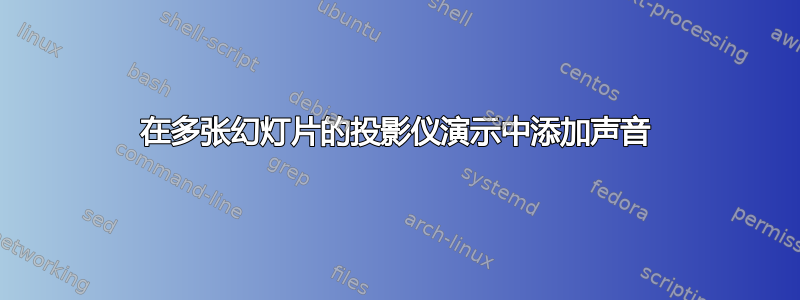
我想在 beamer 演示文稿中加入声音,并且希望声音从某张幻灯片开始,并持续多张叠加或多张幻灯片。我尝试使用media9或来实现这一点multimedia(根据文档,这两种方法都应该有效)。但在这两种情况下(参见下面的 MWE),声音在应该开始的时间开始,但在显示第 2 项时停止。我怎样才能让声音持续多张幻灯片(对于其中一个包media9或multimedia,我不关心哪个)?
MWE 为media9:
\documentclass{beamer}
\usepackage{media9}
\begin{document}
\begin{frame}{1}
1
\end{frame}
\begin{frame}{2}
\includemedia[label=my_sound, width=1ex, height=1ex, transparent, activate=pageopen, deactivate=onclick, addresource=./Sounds/MITM.mp3,
flashvars={
source=./Sounds/MITM.mp3
&autoPlay=true
},]{}{APlayer.swf}
\begin{itemize}
\item<2-> 2
\item<3-> 3
\end{itemize}
\end{frame}
\begin{frame}{3}
3
\end{frame}
\begin{frame}{4}
4
\end{frame}
\end{document}
MWE 为multimedia:(此处该autostart选项也不起作用,我必须手动启动声音,如果没有该选项则根本没有声音inlinesound)
\documentclass{beamer}
\usepackage{multimedia}
\begin{document}
\begin{frame}{1}
1
\end{frame}
\begin{frame}{2}
\sound[autostart, inlinesound, bitspersample=16, channels=2, encoding=Signed, samplingrate=48000]{A}{./Sounds/MITM.au}
\begin{itemize}
\item<2-> 2
\item<3-> 3
\end{itemize}
\end{frame}
\begin{frame}{3}
3
\end{frame}
\begin{frame}{4}
4
\end{frame}
\end{document}
如果这很重要:我在 Windows 11 上使用 Adobe Reader(最新版本)。
答案1
据我所知,目前常用的 PDF 查看器均不支持在多张幻灯片中播放声音。不过,制作一个支持此功能的查看器相当简单。
viewer.html将以下内容保存到名为(或者<anything>.html如果您愿意)的文件中:
<!DOCTYPE html>
<html>
<head>
<meta charset="utf-8">
<meta name="viewport" content="
width=device-width,
initial-scale=1,
maximum-scale=1
">
<style>
/* Make the viewer take up the full screen */
* {
margin: 0;
padding: 0;
border: 0;
outline: 0;
}
#viewer-container {
overflow: clip;
position: absolute;
width: 100%;
height: 100%;
}
/* Center the page */
.page {
margin: 0 auto 0;
}
</style>
<script type="module">
import "https://cdnjs.cloudflare.com/ajax/libs/pdf.js/4.1.392/pdf.mjs"
import "https://cdnjs.cloudflare.com/ajax/libs/pdf.js/4.1.392/pdf_viewer.mjs"
pdfjsLib.GlobalWorkerOptions.workerSrc =
"https://cdnjs.cloudflare.com/ajax/libs/pdf.js/4.1.392/pdf.worker.mjs"
const bus = new pdfjsViewer.EventBus()
const container = document.getElementById("viewer-container")
const viewer = new pdfjsViewer.PDFSinglePageViewer({
container,
eventBus: bus,
textLayerMode: 0,
annotationMode: 0,
})
bus.on("pagechanging", () => {
viewer.currentScaleValue = "page-fit"
})
const file_element = document.getElementById("file")
async function open(event) {
let file
if (event instanceof window.DragEvent) {
event.dataTransfer.dropEffect = "copy"
file = event.dataTransfer.files[0]
} else if (event.target instanceof window.HTMLInputElement) {
file = event.target.files[0]
}
file_element.remove()
const doc = await pdfjsLib.getDocument(
await file.arrayBuffer()
).promise
viewer.setDocument(doc)
const attatchments = await doc.getAttachments()
let audio
async function sound() {
viewer.currentScaleValue = "page-fit"
const page = await doc.getPage(viewer.currentPageNumber)
const annotations = await page.getAnnotations()
for (const annotation of annotations) {
const directive = annotation?.contentsObj?.str
if (!directive) continue
const [cmd, file] = directive.split(" ")
if (["play", "stop"].includes(cmd) && audio) {
audio.pause()
audio = null
}
if (cmd === "play") {
const blob = new Blob([attatchments[file].content])
audio = new Audio(URL.createObjectURL(blob))
audio.play()
}
}
}
function move(direction) {
if (!document.fullscreenElement) {
document.documentElement.requestFullscreen()
} else {
if (direction === "next") {
viewer.nextPage()
} else if (direction === "previous") {
viewer.previousPage()
}
}
sound()
}
document.addEventListener("keydown", (event) => {
switch (event.key) {
case "ArrowRight":
case "ArrowDown":
case " ":
case "PageDown":
case "Enter":
event.preventDefault()
move("next")
break
case "ArrowLeft":
case "ArrowUp":
case "PageUp":
case "Backspace":
event.preventDefault()
move("previous")
break
}
})
document.addEventListener("click", (event) => {
event.preventDefault()
switch (event.button) {
case 0:
event.preventDefault()
move("next")
break
case 2:
event.preventDefault()
move("previous")
break
}
})
}
file_element.addEventListener("change", open)
document.addEventListener("drop", open)
document.addEventListener("dragover", event => event.preventDefault())
</script>
</head>
<body>
<input type="file" id="file" accept="application/pdf">
<div id="viewer-container">
<div id="viewer"></div>
</div>
</body>
</html>
然后,使用 pdfLaTeX 或 LuaLaTeX 编译以下文档:
\documentclass{beamer}
%%%%%%%%%%%%%%%%%%%%%%%%%%%%%%
%%% Load required packages %%%
%%%%%%%%%%%%%%%%%%%%%%%%%%%%%%
%% Needed to embed the audio files
\usepackage{embedfile}
%% Needed for \pdfannot to work with LuaTeX
\ifdefined\directlua
\usepackage{luatex85}
\fi
%%%%%%%%%%%%%%%%%%%%%%%%%%%%%
%%% Variable Declarations %%%
%%%%%%%%%%%%%%%%%%%%%%%%%%%%%
\ExplSyntaxOn
\seq_new:N \g__example_files_seq %% Store all used files
\tl_new:N \l__example_lastfile_tl %% The most recent file loaded
\tl_new:N \g__example_currentfile_tl %% The currently playing file
%%%%%%%%%%%%%%%%%%%%%%%%%%%
%%% Command Definitions %%%
%%%%%%%%%%%%%%%%%%%%%%%%%%%
%% Embeds a file if it isn't already embedded, and stores its attachment
%% name in "\l__example_lastfile_tl".
\cs_new_protected:Nn \__example_add_file:n {
\tl_set:Ne \l__example_lastfile_tl { \str_mdfive_hash:n { #1 } }
\seq_if_in:NVF \g__example_files_seq \l__example_lastfile_tl {
\seq_gput_right:NV \g__example_files_seq \l__example_lastfile_tl
\embedfile [ filespec = \l__example_lastfile_tl ] { #1 }
}
}
%% Writes to the PDF the given command and parameter.
\cs_new_protected:Nn \__example_pdfcmd:nn {
\pdfannot width 0pt~ height 0pt~ depth 0pt~ {%
/Subtype~ /Text
/Contents~ (#1~ #2)
/F~ 1
}
}
\cs_generate_variant:Nn \__example_pdfcmd:nn { nV }
%% Plays the given audio file.
\cs_new_protected:Nn \__example_play:n {
\__example_add_file:n { #1 }
\tl_if_eq:NNF \g__example_currentfile_tl \l__example_lastfile_tl {
\tl_gset:NV \g__example_currentfile_tl \l__example_lastfile_tl
\__example_pdfcmd:nV { play } \l__example_lastfile_tl
}
}
%% Stops the currently playing audio file.
\cs_new_protected:Nn \__example_stop: {
\__example_pdfcmd:nn { stop } { }
\tl_gclear:N \g__example_currentfile_tl
}
%% Expose the commands publicly
\cs_set_eq:NN \playaudio \__example_play:n
\cs_set_eq:NN \stopaudio \__example_stop:
\ExplSyntaxOff
%%%%%%%%%%%%%%%%%%%%%
%%% Demonstration %%%
%%%%%%%%%%%%%%%%%%%%%
%% There are no audio files in $TEXMFDIST, so we need to lookup the
%% (system-dependent) path to a sample audio file.
\ExplSyntaxOn
\sys_get_shell:nnN { kpsewhich~ --format=source~ bird.mp3 } { } \l_tmpa_tl
\iow_term:e {
\iow_newline:
``bird.mp3''~ path:~ \tl_to_str:N \l_tmpa_tl
\iow_newline:
}
\ExplSyntaxOff
\begin{document}
\begin{frame}{Title One}
Body One
\end{frame}
\begin{frame}{Title Two}
%% Replace this path with the path output to the terminal earlier
\playaudio{/usr/local/texlive/2024/texmf-dist/source/latex/media9/files/bird.mp3}
Body Two A
\begin{itemize}
\item<2-> Body Two B
\item<3-> Body Two C
\end{itemize}
\end{frame}
\begin{frame}{Title Three}
\stopaudio
Body Three
\end{frame}
\begin{frame}{Title Four}
Body Four
\end{frame}
\end{document}
最后,viewer.html在网络浏览器中打开,点击“浏览”,然后打开您上面编译的 PDF 文件。单击任意位置将使演示文稿全屏显示,[ Left Click、→、Page ↓、Space、 ] 中的任何一个将向前移动一张幻灯片,[ 、、 ]Enter中的任何一个将向后移动一张幻灯片。←Page ↑Backspace
怎么运行的
在 TeX 方面,我们添加声音文件作为 PDF“附件”,然后将播放/停止命令放置在隐藏的 PDF“注释”内。
在 HTML 方面,我们导入 pdf.js 作为查看器的基础,然后我们对其进行配置以解析每个页面上的注释并使用它们来决定何时播放/停止任何附加的音频文件。
观众是非常基本功能并不强大,但对于基本的幻灯片放映来说应该足够了。添加新功能并使其更强大留给读者练习 :)
答案2
这不是答案,而是我对这个问题的解决方案。我基本上遇到了所描述的问题,经过多次尝试后,我得出结论,它目前并不在 PDF 查看范围内。
因此,我已从基于 beamer 的 PDF 演示文稿转换为使用 reveal.js 等框架的基于 Web 的演示文稿。这样做的缺点是,典型的基于 js 的 latex 渲染引擎仅提供 latex 的一个子集,因此幻灯片的制作时间增加了。
新方法的主要缺点是它更加耗费人力。也就是说,如果我确实需要 KaTex 或类似的基于乳胶的 Web 渲染器不支持的某些乳胶渲染,我会先将标准乳胶渲染为 PNG 文件,并在需要时将其作为图像嵌入幻灯片中。最大的好处是添加音频内容和视频内容变得容易,并且添加交互式内容(以 javascript 程序的形式)非常可行,但需要量身定制。我的工作通常包括算法实现,因此能够在演示文稿中无缝展示工作(无需 alt-tab 等)是很好的。Reveal.js 有库,甚至允许在动画和交互式内容之上进行标记和绘制。我希望这种方法的主要缺点会随着时间的推移而得到克服,留下一个提供所有最佳方案的选择。


